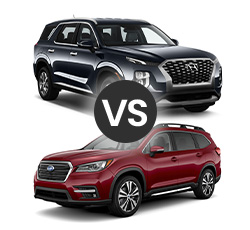2021 Hyundai Palisade vs Subaru Ascent
For those searching for the perfect SUV, look no further. The 2021 Hyundai Palisade and Subaru Ascent offer a wealth of features that make them formidable rivals in their class. From size to capability to modern technological amenities, this comprehensive review will explore all aspects so you can decide which one is right for your lifestyle needs - even if they may be similar on paper.
The Powertrain
The Palisade and the Ascent might not look hugely different at first glance, but a closer examination reveals some key differences. Many customers won't notice that under the hood lies power of epic proportions – when equipped with its trusty V6 engine, the Herculean Palisade can tow up to 5,000 pounds while still offering an agile driving experience. Meanwhile, thanks to its muscular four-cylinder version, the reliable Ascent remains strong and capable enough for any journey you embark on.
Whether it's the heft of a Hyundai Palisade or agile agility of Subaru Ascent, both options offer tremendous power and performance to get you where you need to go. With either model equipped with up-to 291 horses (Hyundai) and 260 ponies (Subaru), these vehicles can take on highways as well city streets at breakneck speeds - so buckle up!
A point of interest is that the Subaru Ascent comes standard with symmetrical all-wheel drive. This system is able to monitor how each wheel is doing, and if power needs to be directed to particular wheels because of issues with traction, then the change can be made immediately. Further, every Ascent has X-Mode and Hill Descent Control. X-Mode enhances performance when conditions are really challenging, and Hill Descent Control can limit the SUV's speed when traveling down steep hills.
Hyundai provides the opportunity to get a Palisade with all-wheel drive. If this option is taken advantage of, then the SUV would be able to shift power around when necessary. A Palisade can be locked into all-wheel-drive mode in low-traction situations, and there's also a snow mode that can be engaged. If the Palisade doesn't have all-wheel drive, it would have front-wheel drive. Hill Start Assist Control, which holds pressure on the brakes when it's stopped on a hill, is standard across the lineup, and Downhill Brake Control is found on every model that has all-wheel drive.
The Subaru Ascent and Hyundai Palisade each offer unique transmissions to suit a variety of drivers. The Ascent comes equipped with the innovative Lineartronic CVT that optimizes performance while keeping fuel costs low, while those craving more control can check out the eight-speed automatic transmission in the Palisade, complete with SHIFTRONIC technology for an added thrill on every ride.
The Hyundai also has something called Drive Mode Select. A driver would be able to choose Sport Mode if he/she wants things to be exhilarating, and Eco Mode would make acceleration much less rapid in order to save gas. There's a Normal mode that would strike a balance in the middle.
The Subarus Ascent and the Hyundai Palisade both offer close fuel efficiency, but depending on whether you prefer city or highway driving, one could have an edge. The Ascent gives drivers optimal mileage with up to 21 MPG in cities and 27 MPG on highways - perfect for those who enjoy hitting back roads or love taking scenic drives. But if cruising around town is more your speed then never fear; the Palisade's 19/26 front-wheel drive estimate still provides great value while its 24 Highway MPG all-wheel configuration ensures stability even when venturing farther afield.
When it comes to warranties, the newly released Ascent and Palisade vehicles offer distinctly different packages for customers. With its powertrain warranty being valid for five years or 60,000 miles of use, the Ascent provides an average amount of coverage - although that may still meet many drivers' needs. On the other hand, those seeking more extensive protection can choose the Palisade with a full ten-year/100,000 mile warranty on its powertrain - providing peace of mind no matter how much you drive!
Drivability
Get ready for some fun in the driver's seat - the 2021 Hyundai Palisade and 2021 Subaru Ascent offer a little excitement with their larger size! These vehicles boast impressive measurements of 196.1 inches long, 77.8-inch width (Palisade) or 2'' narrower for the Ascent, plus ground clearances of 8’‘ and 8.7" respectively to tackle any terrain ahead!
Since they have very similar exterior dimensions, one would assume that inside their cabins, there would be a comparable amount of space. First, second, and third-row leg room in the Hyundai Palisade is 44.1, 42.4, and 31.4 inches, respectively. In the Subaru Ascent, those numbers are 42.2, 38.6, and 31.7 inches.
Ride around town in ultimate comfort with the Palisade or Ascent, where passengers up front can relax without worry and those towards the back may still find it surprisingly spacious. There's even plenty of room for kids in row three - so you don't have to pack light when taking a family trip! Step into row two on either vehicle and you'll be met with generous legroom that keeps everyone feeling comfortable no matter how far they go!
With both models, customers have the choice of getting captain's chairs or bench seats in their middle rows. Captain's chairs can make things feel more stately and more spacious, and people will have an easier time getting in and out of the third row. Having bench seats, though, does provide an extra seat.
With its three rows of seats, the Palisade and Ascent SUVs are great for larger families. The downside? A slightly smaller cargo area compared to other vehicles in their class - 18 cubic feet behind the third row. But don't let that scare you off! With all rear seats folded down, these models provide an ample amount of space with a maximum capacity reaching 86+ cubic feet – plenty roomy enough for hauling any gear or supplies around town.
As drivers of these vehicles travel around town or go on road trips, they'll be able to rely on smartphone compatibility to stay in touch with others and look up certain types of information. Plus, every Ascent trim has SiriusXM to keep people entertained.
The Palisade's lower trims have eight-inch touchscreens, and the higher ones have 10.25-inch touchscreens with integrated navigation. Bluetooth, Android Auto, and Apple CarPlay are standard, and there's a Rear Seat Quiet Mode in case passengers want to have peace and quiet or prefer to listen to their own media content. Available on the Pasliade are an in-vehcile intercom, a Harman Kardon 12-speaker sound system, and wireless charging. All trims have at five USB ports in the first and second rows, and higher trims have two additional USB ports in their third rows.
A 6.5-inch touchscreen is found in the base model of the Subaru Ascent. Higher trims can have eight-inch touchscreens with navigation. If one is focusing on size only, the Palisade would win this competition. Keep in mind, though, that the Ascent has SiriusXM and available Wi-Fi capability. Its higher trims can have Harman Kardon sound system as well. These systems come with 14 speakers. Like the Palisade, the Ascent comes standard with USB ports in the first and second rows. It only has four USB ports in comparison to the Palisade's five ports. The top half of the Ascent lineup has two more USB ports in the third row.
To avoid overpaying on a new car, shop prices online first. Get up front pricing before you walk into a dealership. We recommend the following free services; Car Clearance Deals, NADAguides, CarsDirect & & Motortrend.
These free services will offer you the lowest prices and supply you with multiple competing price quotes. You will know the best price before you visit the dealer.
Safety
Subaru and Hyundai have both gained recognition for their commitment to providing safe, high-quality vehicles. Subaru has a long history of delivering on its promise of safety while Hyundai is pioneering the use of driver assist technologies in modern cars. Together they are helping revolutionize driving technology as we know it!
The Subaru Ascent is the future of automotive safety! With each trim level equipped with EyeSight Driver Assist Technology, this vehicle offers industry-leading pre-collision braking and lane departure warnings. Plus, you'll be seeing clearly in all conditions thanks to automatic high beams lighting up the road ahead plus a rear vision camera for reversing at night or low light situations. Move up to the higher trims and get even more protection from reverse automatic braking that helps avoid certain types of accidents in parking lots as well 180° perspective cameras around front occupants - so no matter where you are driving your family will stay safe on every journey!
The Palisade is packed with countless safety features like forward collision alert, adaptive cruise control and automatic emergency braking that make it one of the safest rides on the road. It also features driver attention alert to ensure your concentration never drifts from driving as well as rear cross-traffic/blind spot detection for added visibility when you're behind or alongside someone else's car! For further parking assurance, this SUV offers a convenient distance warning system plus optional surround view monitors - perfect for those tight spaces.
Get ready to take your driving experience up a notch with the new Palisade's head-up display. This helpful feature projects vital information like speed limit, warnings systems and more directly onto the windshield behind the steering wheel so you can stay informed without compromising visibility on busy roads!
Which Has the Best Value?
If you're in the market for a vehicle that packs plenty of power and convenience, but don't want to break the bank - look no further than these two trims. The Subaru Ascent has all that you need at an affordable starting cost of $32,295 while its rival the Hyundai Palisade doesn’t lag too far behind with just a small increment to bring it up to $32,675. Both cars have stunning exterior designs along side luxurious indoor features which make them exactly what any driver would be after!
The Palisade's SEL trim costs $35,325, and the Limited costs $45,275. This significant price increase is likely due to the trim's Nappa leather seats, heated and ventilated front seats, heated rear seats, larger touchscreen with navigation, surround view monitor and other advanced safety components, ambient lighting, sunroof, and hands-free smart liftgate. Plus, there's a Calligraphy trim that has even more refined elements than the Limited does. It costs $46,200.
Experience the luxuries of life without breaking the bank with Subaru Ascent. Starting at just $34,795 for its Premium trim and up to a Touring model priced at only $45,445 - there are plenty of options that satisfy any budget. Enjoy all your beloved amenities on those cold mornings or long night drives while you relax in heated front seats found exclusively in this lineup! You'll never find another deal quite like it as even their highest tier offers few features more than what's available from comparable trims of other vehicles but comes out costing over five grand less!
Which is Better?
For drivers searching for the perfect three-row SUV, they have two great options to choose from. While both offer ample interior space - with a slight advantage in legroom going to the Palisade's second row - it is what lies beneath its sleek exterior that truly sets the Palisade apart. Boasting an abundance of modern tech elements and innovations, this vehicle will undoubtedly satisfy those who crave cutting edge technology within their car!
On the flip side, the Subaru Ascent offers ultimate practicality - boasting a more wallet-friendly price tag and additional features such as standard all-wheel drive and X-Mode for increased durability. With this vehicle, you'll be prepared to tackle the toughest challenges life throws your way.
Customers looking for a reliable daily driver have the option to choose between two models - one offering enhanced features at an additional cost, and another sure to provide dependable performance. It's up to individual buyers whether they think that paying extra for those extras is worth it with the Palisade.

Get up to 4 local dealers to compete for your business by offering free, competitive pricing. Know before you go to the dealer.
Every dealer offers a secret price. Find yours here.
• 2021 Hyundai Palisade VS Ford Explorer
• 2021 Hyundai Palisade VS Honda Pilot
• 2021 Hyundai Palisade VS Kia Telluride
• 2021 Hyundai Palisade VS Subaru Ascent
• 2021 Hyundai Palisade VS Toyota Highlander


